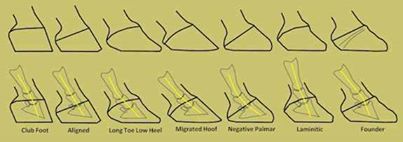I also want to add this -
When I/we started with the Shetlands in 1995 up in MT, no "real" farrier would do the "*!??!" mini horses. We'd had our 3 yr old stallion for a little while and he had an abscess "blowout" right at/above his coronet band on his left hind leg. The vet commented that he really was overdue for a trim all the way around (I knew that) and when we hauled him in to the clinic for him to clean out the abscess, while AJ was asleep on the SX table, he did all 4 hooves. I, of course, asked if he'd trim up the little mare as well. His comment - "NO, not unless we have some reason to operate, but this is why most farriers won't do them. I recommend that you get some tools, some books and learn to do them yourself. If you can get to one of these farrier schools, this one and that one are GOOD..."
It took forever for that abscess to heal and in the meantime, AJ became VERY BAD about allowing that leg to be handled, lifted off the ground. He'd tuck it up behind his left front hoof, dropping his left hip down and almost dog sitting - every time you went to handle that left hind leg. He'd even sometimes put it down in between his two front hooves and stand like that. It was not funny to watch him learn to balance like that - when we were trying to get him trimmed. Then in April 1997 we moved to NC and the first several farriers agreed to do the small ponies' hooves but they all wanted to beat the stuffing right out of AJ. That didn't work for me and I was stuck doing him. I found the easiest way to draw up that leg was to put a rope around it and pull it up and out BEFORE he had it between his front legs. Didn't always happen , though, LOL. Then I found a farrier willing/able to do the small ponies (she was a tiny woman and could get under my babies, too) - and she worked with me to do the hooves on the babies and youngsters and on AJ.
She went thru a divorce and moved on, so I went the rounds again finding a farrier that would work on the little ones and it was never easy. Even NOW - 20 years later - here in NC, if you say that you have Shetlands or Minis, a lot of farriers say "No Way". Others will come out - but both men and women have been "bristly" - like they are coming out to get into a fight - "well, you know, you have them thar, NASTY SHATLANDS..." . Others talk a good show, start to do a trim and if doing AJ and he yanked his leg away (he finally got to the point we could do his hooves w/o dogsitting, but he then broke off a piece of his hip bone and now & then it would bother him or maybe he didn't like some of the farriers I called to come out??), they blew up - yanking his leg and pounding on him. They didn't come back out... I did more trims on him myself. Then first Austin came along (active duty Army - trimming hooves as a sideline) and he was AWESOME - even tho he was not a small guy. He'd get down on the ground and do hooves if needed. We even had one colt that wanted to lay down when he did his hooves - he did them upside down and we'd get him up to check... Happened a few times. AJ and he seemed to get along GREAT. Then he had to go out of state (duty called) & he recommended someone.
Well, she came out (I already sorta knew her as an acquaintance) and it's been up/down. I don't always agree with everything she says/does. Sometimes I ask her to do something different OR she makes recommendations to me. That started in 2011 and she is still our farrier. She comes out 1-3 times a month. From the time she started until June 2012, she and AJ had an interesting relationship - she stated that she/he would have a GREAT day or a SO-SO day by the way he pointed his ears (I never saw that) and sometimes she asked to do him first and others last. Sometimes he gave her 7734 (he would dog sit & sometimes yank the leg away, after which he snapped a hard kick forward & out<cowkicking>, regardless of what I did while holding him), and others he was quiet and solid as a rock - practically holding each leg up for her before even asked for...
I do posts now and then with Cat's pics. I've learned much and YES, she does follow some of Pete Ramey's info but also does other things as well... It's good to learn more about your horses hooves and the requirements. It's amazing how much there is to learn and what new things we are discovering.




